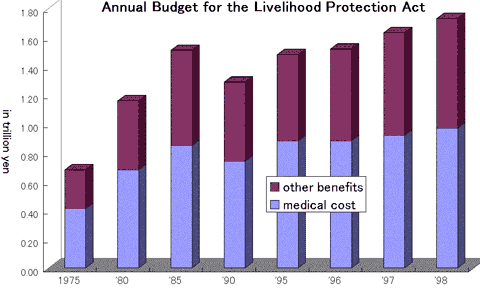|
Chapter 9 . Social Welfare |
| 1. Welfare for the Indigent |
|
The article 25 of the Constitution states that "All nationals shall have the fundamental human right to live healthy and cultural livelihood in the minimum" and the statement issued by the Social Security Committee in 1950 defines the social security as "economic assurance against potential causes of poverty either by way of insurance or public subsidy but for those who fall below poverty level, the public subsidy shall guarantee the minimum livelihood as declared in the Constitution". Under this policy, anybody who fell below the preset level of poverty will be entitled to the means-tested "Livelihood Protection Act". To administer the system, all cities have social welfare offices staffed by caseworkers. Anybody who wishes to receive the welfare benefit for the indigent must apply and undergo means tests. There are eight kinds of benefits: living expenses, education, housing, long term care, delivery, occupational assistance, funeral and medical care. The system is heavily affected by the economics of the country. In 1965, 1.63% of the total population was on the roster of the indigent. The percent has consistently declined to hit the low of 0.7% in 1995. However, Japan's long lasting economic slumps are casting dark shadows over the system: the percent of the roster is on the rise again. The figure in 1998 was 0.75% and may be even higher today. As for medical care, recipients of the Livelihood Protection Act are mostly exempt from compulsory national health insurance system and their medical bills will be paid from general tax. Diseases remain as the main cause of falling into poverty and as much as 80% of the recipients are receiving medical care. In financial terms,  medical cost accounts for approximately 56% of the entire budget of the system. |
| 2. Maternal and Child Welfare |
|
Social security for mother and children families is two fold: for those whose father died, survivors' benefit of the pension system will apply, but those who divorced with father will not qualify for the survivors' benefit. However, the recent sharp increase of divorce has brought the mother and children family issue on top of the social problem list. Japan's divorce was approximately 250,000 in 1999 or 2 per 1000 population. This figure is far smaller than the U.S. with 4.34 divorce rate. However, Japan's figure has more than doubled when compared with 1975. Divorced spouses still owe legal liability to support the children, but their fulfillment of their obligation is generally not satisfactory. To provide financial support, the government provides the "Children Support Subsidy" to mother and children families. Benefits are available not only to divorced families but also to unmarried mothers. Monthly benefit is 42,370 yen ($350) for families with one child and 664,381 mothers are on the roster. The government disbursement exceeds 300 billion yen and is increasing. The financing of the "Children Support Subsidy" is becoming a heavy financial burden for the government. |
| 3. Welfare for the disabled |
|
There are estimated to be 413,000 (3.5 per thousand population) people with intellectual impairment as of September 1995, approximately 3 million (24 per thousand population) people with physical disability as of November 1996, and 2.17 million (17 per thousand population) patients with mental disorder as of October 1996. Livelihood of those disabled is mainly supported by disability pension, which becomes available when the disabled reaches 20 years old. The annual amount is approximately one million yen ($8,300) for severe disability and 800,000 yen ($6,700) for moderate disability. For the disabled younger than 20 years old, the "Subsidy for Disabled Children" will be paid to their parents or custodians. The monthly amount is 51,550 yen ($430) for severe disability and 34,330 yen ($286) for moderate disability. To detect preventable causes of intellectual impairments such as phenylketouria, mass screening program for neonates has been conducted since 1977. By 1998, 5,672 Cretinism, 2,330 neuroblastoma, 371 phenylketonuria have been detected to  assure prompt treatment. In a somewhat odd contrast, intrauterine diagnoses of Down syndrome and other detectable anomalies are not actively performed. The number of physical disability has consistently increasing reflecting the population ageing. The number of internal organ impairment includes renal failure patients on dialysis and accounts for most of the recent increase of the number of people with disability.  |
  
|